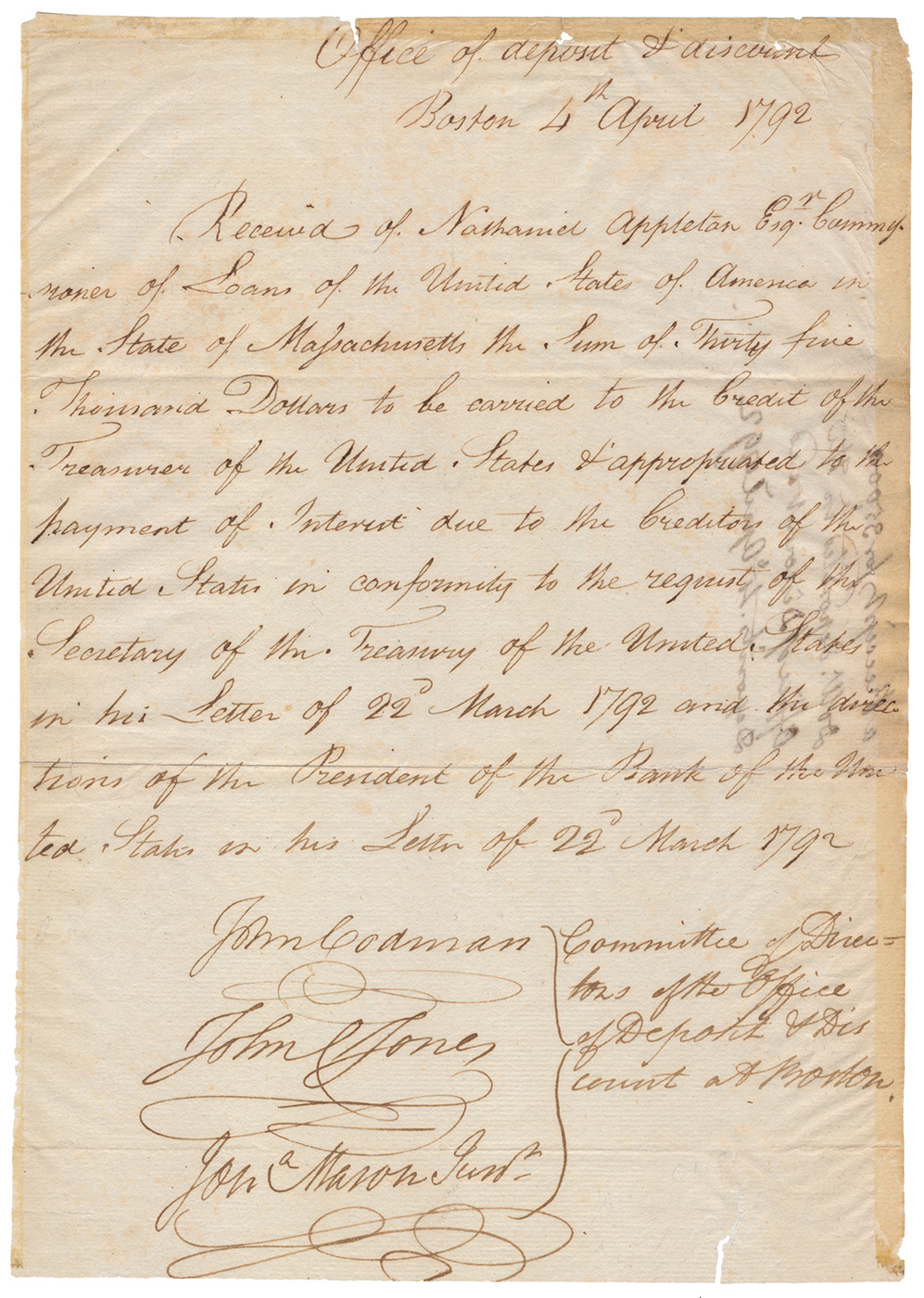
(Alexander HAMILTON) Important manuscript Document Signed “John Codman“, “John C. Jones“, and “Jona Mason Junr” as Directors of the Office of Discount and Deposit at Boston, 1p., 270 x 190 mm. (10 3/4 x 7 1/2 in.), 4 April 1792, acknowledging receipt of $35,000 collected from the Customs House by the Commissioner of Loans, Nathaniel Appleton, to be used to pay interest on the national debt to relieve pressure on the Bank of the United States during the Panic of 1792.
The document reads in full: “Received of Nathaniel Appleton Esq.r Commissioner of Loans of the United States of America in the State of Massachusetts the Sum of Thirty five Thousand Dollars to be carried to the Credit of the Treasurer of the United States & appropriated to the payment of Interest due to the Creditors of the United States in conformity to the request of the Secretary of the Treasury of the United States in his Letter of 22d March 1792 and the directions of the President of the Bank United States in his letter of 22d March 1792“.
The Panic of 1792 had its roots in the rapid expansion of credit by the newly-formed Bank of the United States, and rampant speculation in government securities led by William Duer and Alexander Macomb. In early March 1792, Duer, greatly overextended, began to default on his obligations. To make matters worse, when Duer left his position as Secretary of the Treasury Board in 1789, he left a shortage of $238,000 on the government books. Hamilton had indulged his friend, allowing him time to settle his accounts, but when news of Duer’s pending insolvency reached him in late March, he was forced to initiate a suit, lest he be accused of laxity and nepotism by his political enemies.
Hamilton’s suit made Duer’s situation public and a panic ensued which placed enormous pressure on the Bank of the United States, and in particular, its ability to pay interest on the national debt in specie. Part of Hamilton’s strategy to alleviate the pressure on the banks was to order that specie received from the customs offices be used to pay the quarterly interest payment due. In his 22 March 1792 instructions to Nathaniel Appleton, Commissioner of Loans, Hamilton ordered him “…to avail yourself of all the specie in the hands of the Collector of Boston, excepting only the sum of 6,000 Dollars, which is to be retained by him, to meet certain bills of the Commissioner of Loans in New Hampshire, which he is authorized to direct to the Collector. The remaining specie the Collector is to deposit in the Boston Branch of the Bank of the United States, for the purpose of paying the interest on the public debt. He is also to pay in all the notes of the Bank of the US to be deposited in such way or form as the said Branch shall determine to receive the paper of the Bank of the United States.” The next week, Appleton deposited $35,000 with the Office of Discount & Deposit at Boston, the Massachusetts branch of the Bank of the United States, for which he received the present receipt.
Hamilton’s rapid and decisive actions during the panic prevented a larger financial disaster and by May the panic had largely subsided. However, Hamilton was unable to do much for his friend Duer. The disgraced speculator spent the remainder of his life in debtor’s prison for fear of his personal safety. Because so many had given their life’s savings to Duer to invest, a guard had to be posted at his cell to prevent a mob from hanging him in the street.
The Directors of the Boston branch who signed this document include John CODMAN (c. 1755-1803) a prominent Boston merchant and member of the Massachusetts Senate; John C. JONES (?-?) a Boston merchant; and Jonathan MASON Jr. (1756-1831) a prominent Federalist attorney and member of the Massachusetts House of Representatives who served two terms in the United States Senate (1800-1803, 1817-1820).
Toned at margins from previous mounting, minor marginal tears as shown, else very good.
(EXA 3504) SOLD.
